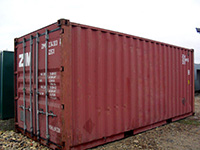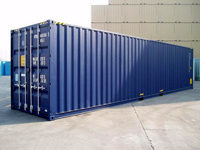
There are a few things that you need to look for when your thinking about buying a shipping container – so Shipping Containers New Zealand have put together the following 7 points as a guide for you to follow to make the process as easy and informational as possible.

1
What will you be Using the Shipping Container For?
The first thing to consider is what the container will be used for. Will it be for long or short term storage, moving or relocating, building, or shipping overseas? All of these categories will give you more options on what you should be looking for in a container, and should definitely be considered when your setting out your budget too.
For instance, when you are looking at building a shed or house by joining or stacking more than one container, you should buy brand new – as most cargo worthy will come with small dents or patches of rust, and you want a blank canvas when building.
If you’re just storing furniture or relocating, a cargo worthy container will work quite well, and once you have decided on the use and type of container needed, you also need to decide on a size. The standard sizes are 10ft, 20ft and 40ft, but you can also get containers in other sizes, like 8ft, or 45ft. This can also affect your budget, as a 10ft, while being small enough to fit in anyone’s backyard, is more expensive than a 20ft container, as there are more labour costs behind it.
2
Have you looked at Delivery Options?
Depending on your location, delivery of your container can affect the timeframe of delivery and the cost. Areas that are isolated could easily have a container dropped off to them, however finding a delivery driver to get out there in a timely manner could be time consuming. In a city, there could be many trucks around to deliver a container, however the access could potentially be difficult and require more planning with regulatory bodies, therefore increasing the cost.
Truck type will also play a part in the delivery cost and planning – there are three main type of trucks used in delivering containers, a tilt tray, a side loader, and a HIAB. A tilt tray will need plenty of space in front of the delivery area for the container, as it tilts the container off the back of the truck tray and drives forward. The side loader will use lifting arms to offload the container off the side of the truck, so it will need more space to the left or right of the delivery space – similar to the HIAB, which uses a truck mounted forklift to lift the container up and off to the side.
3
Do you need modifications to the shipping container?
Any modifications that may be needed should also be taken into consideration – this can be decided when you know exactly the use of the container. For example – a container used for long term storage would have a lockbox recommended as it adds an extra layer of security to the door, which is the most vulnerable area of a container. This is a metal box welded over the padlock – preventing it from being tampered with. Or if you are looking to get a container to turn into a site office or house – a large amount of modification work will need to be done. Similarly to planning a house, the best option here is to sit down and note everything that will be required, and everything that is wanted so you can go through this list with a professional and get firm prices.
4
Is your site prepared for a shipping container?
Proper care of your container will be required to make it last forever – and this includes having level ground for the container to sit on. If the container will be sitting on soil, any moisture trapped underneath it can rise into the subfloor, creating mould – which means your container won’t last as long as it should. Depending on the surface your container will be sitting on, there are certain steps you can take to make sure you get the most of your container.
One of the first things to do is to prepare the site – clear the area you want the container to sit of any trees, branches or debris. Then you need to decide if you need a foundation – and if so, which kind of foundation you want to use. A few different things to take into consideration are the total weight of the container, the ground material (soil, sand, concrete etc), area water levels, sanitation required, labourers required, council by laws and region climates.) There are three common types of foundations: a concrete slab, concrete footings, or wooden slabs.
5
Do you need insurance for your shipping container?
Always speak to your shipping container provider about your responsibility when it comes to the agreement when buying or hiring. More often than not, this will be something you will need to organise yourself! More often than not, you will just insure the contents of your container, and usually only if you’re storing for a long period of time or if you’re shipping your contents. However never forget to investigate the insurance first before you start modifying containers for any sort of building.
6
Professionalism
Making sure you deal with a professional company when buying a shipping container will make the purchase easy. Specialized advice, quality and service will guarantee you a superior product which is suited to your actual needs, in your budget and delivered in a timely cost effective manner.

